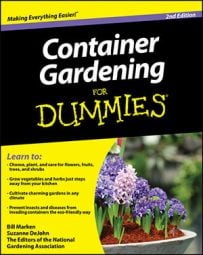Because the nature of garden soil changes when you confine it in a pot, it’s important to use a soil mix specifically formulated for containers. If you take a look at the ingredients on a bag of soil mix, you may notice that there’s very little, if any, real soil listed.
Two things are really essential to growing plants in containers:
Good water flow, optimal drainage, and moisture retention: In garden soil, water is pulled down to the roots by gravity, capillary action, and the attraction of small clay particles. The water keeps moving down through the soil in a continuous column. Because the soil in a container is so confined and the soil column (depth of soil) is relatively shallow, this flow is impeded. The soil mix needs to have a looser structure to encourage this flow of water.
Good water flow helps excess water drain from the soil. Remember, plant roots need both water and oxygen. If the soil they’re growing in is saturated, there’s no room for oxygen. If it remains too wet for too long, the roots will begin to drown and rot, and if enough roots die the entire plant will die, too. For healthy plant growth water must move through the soil, moistening it without leaving it waterlogged.
On the other hand, you don’t want all the water to run right through the soil and out the drainage hole. Plant roots need a consistent supply of both water and oxygen. They can’t go without one or the other for very long. A soil mix that dries out too quickly multiplies your watering chores. In a nutshell: The ideal soil mix drains freely but also retains some moisture.
You may have been told to put a layer of pea gravel or pot shards in the bottom of your container to improve drainage. Don’t do it! Although it may sound logical, using pea gravel in the bottom of a pot actually results in less air for the plant’s roots because it shortens the soil column. Instead, fill the entire container with the same soil mix, covering the drainage holes at the bottom with screening to hold in the soil as needed.
Plenty of pore space: One of the ways a soil mix can drain freely and retain moisture is by having both large and small pores (macropores and micropores). When the mix is watered, the water drains quickly through the macropores but is held in the micropores. The pores are in between individual soil particles, and also between the soil aggregates.
Don’t worry; you don’t need to know the specific pore spaces of different soil mixes. Just know that a mix formulated for plants that need excellent drainage and tolerate dry soil, like cactuses, will have plenty of macropores. That means this soil mix will also be a good choice for other plants that need excellent drainage — succulents like agave and sempervivum (“hens and chicks”), for example. If you’re growing plants like rosemary and lavender that need very good drainage but more moisture than cactuses, you may combine a cactus mix 50:50 with a regular soil mix. Now that you understand the principles you can mix and match soil mixes to suit the plants you’re growing.
Container mixes need to be free of diseases, insects, and weed seeds. Garden soil loses out on all counts for container planting. In the garden ecosystem, beneficial microbes help keep harmful ones in check. Placing garden soil in a container disrupts this balance. You can pasteurize the soil with heat to kill disease organisms, but this is not an easy task and the odor produced by the process is not pleasant.

